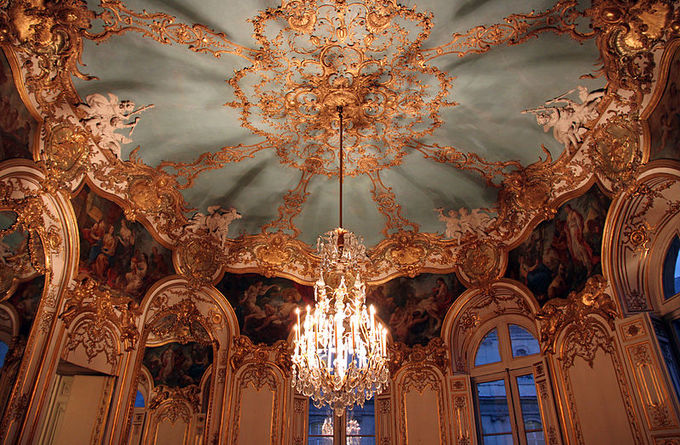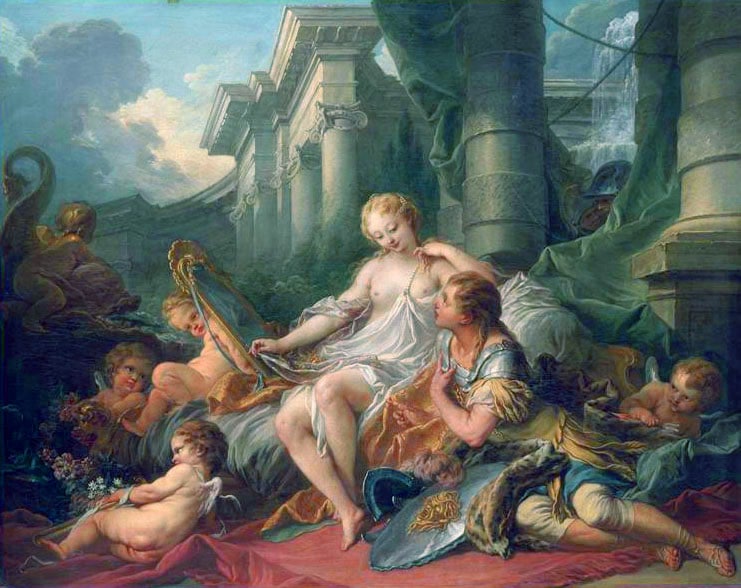The Basics
Rococo is a style in interior design, the decorative arts, painting, architecture, and sculpture that originated in Paris in the early 18th century but was soon adopted throughout France and later in other countries, principally Germany and Austria. It is characterized by lightness, elegance, and an exuberant use of curving natural forms in ornamentation.
The Rococo style represented a reaction against the ponderous design of Louis XIV’s Palace of Versailles and the official Baroque art of his reign. Several interior designers, painters, and engravers, among them Pierre Le Pautre, J.-A. Meissonier, Jean Berain, and Nicolas Pineau, developed a lighter and more intimate style of decoration for the new residences of nobles in Paris.
French Rococo painting in general was characterized by easygoing, lighthearted treatments of mythological and courtship themes, rich and delicate brushwork, a relatively light tonal key, and sensuous coloring. Rococo sculpture was notable for its intimate scale, its naturalism, and its varied surface effects.
Rococo design is characterized by its lighter style of ornamentation, delicate curves, shell forms, and natural shapes. Asymmetrical designs were also very popular, as were light pastels, ivory white, gold, and mirrors.
Decorative Arts
In 18th century Europe, the Rococo style became prevalent in interior design, painting, sculpture, and decorative arts.
In French, the word salon simply means living room or parlor, and Rococo salons refer to central rooms that are designed in the Rococo style. In addition, the notion of the ‘salon’ is an Enlightenment era ideal that transformed the living room into the central space for aristocracy to entertain guests and engage in intellectual conversation. The idea that one’s architectural surroundings should encourage a way of life, or reflect one’s values, was the philosophy of the time.
As another means of reflecting status, furniture rose to new heights during the Rococo period, emphasizing the lighthearted frivolity that was prized by the style. Furniture design became physically lighter, so as to be easily moved around for gatherings, and many specialized pieces came to prominence. Furniture in the Rococo period was also freestanding, as opposed to wall-based, in order to accentuate the lighthearted and versatile atmosphere that was desired by the aristocracy.
Rococo salons often employed the use of asymmetry in design and interior ornament that included the use of sculpted forms on ceilings and walls, often somewhat abstract or employing leafy or shell-like textures.


Painting
Painting during the Rococo period has many of the same qualities as other Rococo art forms such as heavy use of ornament, curved lines and the use of a gold and pastel-based palette. Additionally, forms are often asymmetrical and the themes are playful, even witty, rather than political, as in the case of Baroque art. Themes relating to myths of love as well as portraits and idyllic landscapes typify Rococo painting.
Many Rococo paintings feature refined yet jovial subject matter—an approach that was popularized by French painter Antoine Watteau. As the father of the fête galante—a genre of painting that favors garden parties, festivals, and other outdoor events as subject matter—Watteau produced whimsical scenes of people socializing in pastoral landscapes. Often featuring fluttering Cupids, Greek goddesses, and other mythological figures, these depictions blend fantasy with reality.
In addition to these open air settings, many Rococo paintings take place in opulent interiors. Like fête galante paintings, these pieces often feature amusing iconography and mythological influences.
Rococo paintings showcase an exquisite attention to detail. Inspired by Renaissance artists, French painter François Boucher is renowned for his interest in emphasizing the intricacies of a scene. His detail-oriented approach to painting materializes as impossibly ornate costumes and “elaborately decorative” skies.
While Baroque paintings are associated with deep colors and emotive shadows, Rococo works are characterized by an airy pastel palette. Jean-Honoré Fragonard captures the alluring light-heartedness of this color scheme in his most famous painting, The Swing. Set in swirls of light green foliage, The Swing stars a woman dressed in a pale pink dress playing on a swing and flirtatiously flinging off her shoe.

